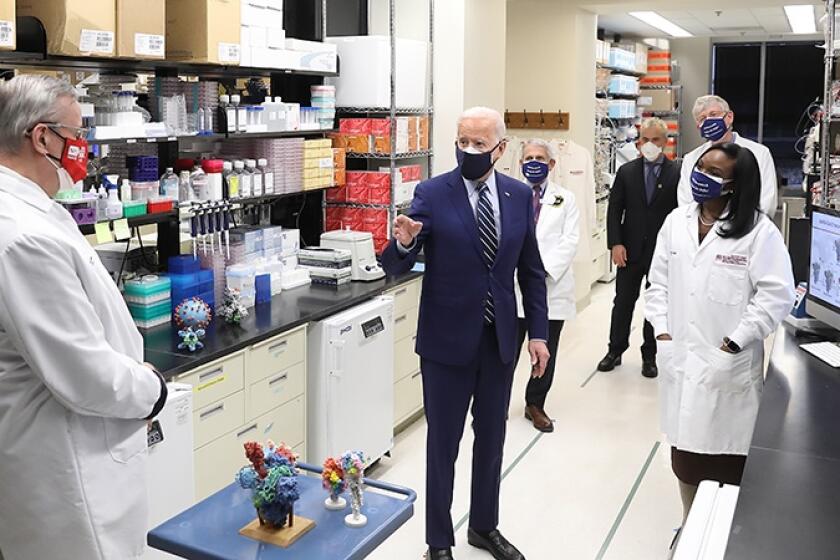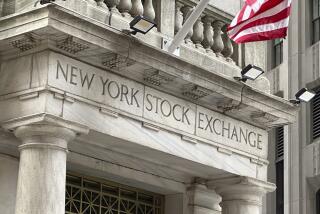Stocks sink as Omicron, rate worries rattle Wall Street

- Share via
Already unnerved by the newest coronavirus variant, Wall Street deepened its losses Tuesday after the head of the Federal Reserve said the central bank will consider shutting off its support for financial markets sooner than expected.
The Standard & Poor’s 500 index fell 1.9%, erasing its gains from a day earlier. The sell-off accelerated after Fed Chair Jerome H. Powell told Congress the central bank may halt the billions of dollars of bond purchases it’s making every month “perhaps a few months sooner.”
It had been on pace to wrap up the purchases, meant to goose the economy by lowering rates for mortgages and other long-term loans, in June.
An end to the purchases would open the door for the Fed to raise short-term interest rates from their record low near zero. That in turn would dilute a major propellant that has sent stocks to record heights and swatted away concerns about an overly pricey market. As investors moved up their expectations for the Fed’s first rate increase after Powell’s remarks, yields on short-term Treasurys rose.
Losses for stocks mounted quickly, with the drop for the Dow Jones industrial average more than tripling in half an hour as it sank 711 points. The blue-chip index ended down 652.22 points, or 1.9%, at 34,483.72.
The Nasdaq composite held up slightly better than the rest of the market, shedding 245.14 points, or 1.6%, to close at 15,537.69. Higher interest rates tend to hurt stock prices broadly, but they hit hardest those seen as the most expensive or those banking on big profit growth the furthest in the future. Such companies play a bigger role in the Nasdaq than in other indexes. Microsoft fell 1.8% and chipmaker Nvidia slid 2.1%.
The whammy on interest rates came after stocks were already weak in the morning because of concerns about how badly the fast-spreading Omicron variant of the coronavirus may hit the global economy.
The chief executive of Moderna predicted in an interview with the Financial Times that existing COVID-19 vaccines may be less effective with Omicron than earlier variants. Regeneron also said Tuesday that its monoclonal antibody treatment may have reduced effectiveness on Omicron. Moderna fell 4.4%; Regeneron dropped 2.7%.
Thanks to the astounding success of its COVID-19 vaccine, Moderna is locked in a fierce battle with the U.S. government over who should get credit.
Much is left to be determined about the variant, including how much it may slow already gummed-up supply chains or scare people away from stores. That uncertainty has sent Wall Street through up-and-down jolts as investors struggle to handicap how much economic damage Omicron will ultimately do.
“There will be heightened volatility around any piece of information,” said Kristina Hooper, chief global market strategist at Invesco. She said markets will probably remain cautious “before we know more.”
The S&P 500 dropped 88.27 points to 4,567. The benchmark index sank 2.3% on Friday for its worst loss since February, only to rise 1.3% on Monday as investors reconsidered whether the reaction was overdone, before giving way to Tuesday’s loss. The index closed out November with a 0.8% loss. That follows a 6.9% gain in October and a 4.8% drop in September. The index is now up 21.6% for the year.
One measure of nervousness in the stock market jumped almost 19% on Tuesday, nearing its level from Friday, when it touched its highest point since March. Much of the rise occurred after Powell began speaking.
Gold usually does well when fear among investors is rising, but its price slipped 0.5%. Higher interest rates could reduce the appeal of gold, which doesn’t pay its holders any interest.
The owner of the largest modern home in America tells a bankruptcy court it plans to have a high-end auction house sell the Bel-Air property.
Object preview
Crude oil prices slid with concerns that a global economy weakened by Omicron would burn less fuel. Benchmark U.S. crude dropped 5.4% and touched its lowest level in three months. Brent crude, the international standard, fell 3.9%.
If Omicron ultimately does heavy damage to the global economy, it could put the Federal Reserve in a difficult spot. Usually, the central bank will lower interest rates, which encourages borrowers to spend more and investors to pay higher prices for stocks.
But low rates can also encourage inflation, which is already high across the global economy. Powell acknowledged in his testimony before Congress that inflation has been worse and lasted longer than the Fed expected. For months, officials described inflation as only “transitory,” but Powell said that word no longer works.
The subsequent losses for stocks Tuesday were widespread, with all but seven stocks in the S&P 500 ending lower. Apple rose 3.2% for the biggest gain in the index.
Smaller stocks also took heavy losses. The Russell 2000 index slid 43.07 points, or 1.9%, to 2,198.91. Investors typically see them getting hurt more than their larger rivals by both higher interest rates and a weaker U.S. economy.
One signal in the bond market was also flashing some concern about the economy’s prospects. Longer-term Treasurys usually offer higher yields than shorter-term Treasurys, in part to make up for the increased risk that future inflation may eat into their returns.
A 10-year Treasury is still offering more in yield than a two-year Treasury, but the gap narrowed sharply Tuesday. The two-year yield rose to 0.54% from 0.51% late Monday. The 10-year yield, meanwhile, fell to 1.45% from 1.52%.
Many investors see that narrowed gap as meaning the bond market has less confidence in the economy’s long-term strength. If it were to flip, with short-term yields rising above long-term yields, many investors would see that as a semi-reliable predictor of a recession.
— Associated Press writer Alex Veiga contributed to this report.
More to Read
Inside the business of entertainment
The Wide Shot brings you news, analysis and insights on everything from streaming wars to production — and what it all means for the future.
You may occasionally receive promotional content from the Los Angeles Times.












